Biorock Helps Corals Survive Environmental Threats
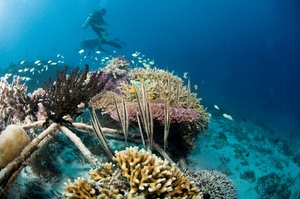
New birth of corals with some help from humans.
Corals are fussy animals. They need just the right conditions to live in. The right amount of sunlight, right amount of carbon dioxide and oxygen, and right amount of food.
They also need pollution-free water and ideal water temperatures. They need to be left alone too to grow slowly, just about the size of one to ten centimetres a year depending on the specie - away from dredging fishing vessels, bomb blasts, and coral stepping snorkelers and scuba divers.
But such a utopia for corals no longer exists in many parts of the world, said Dr Thomas J Goreau (Tom), president of the Global Coral Reef Alliance at the 6th Biorock Workshop on the Gili Islands from 1-7 December 2008. Stress factors are numerous on a local, regional and international scale and they collectively stunt, bleach or kill corals.
Some misguided researchers and managers, according to Tom, also tend to penalise fishermen for fishery collapse and algal blooms instead of addressing the real problems. Fishermen were the first to notice and suffer from the ecological impacts of algae killing reefs due to sewage and fertilizer nutrients in the coastal zone, for which they were unfairly blamed for. Their impact was minimal compared to the coastal development taking place that was at unsustainable levels.
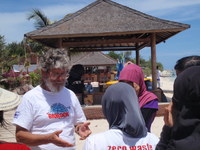
Tom warns of environmental stresses.
“Bad science resulted in bad policy,” said the longest diving marine scientist.
Tom highlighted that the traditional top down approach with NGOs pushing their agenda on communities resulting in formation of marine park areas and police state impositions do not tackle the root causes of coral reef deterioration.
Speaking to the workshop participants, he explained that the current environmental crises on marine ecosystems affect not just Indonesian islands, but around the world. Localised threats are coastline development causing sedimentation, deliberate coral reef destruction by resort operators, bad fishing practices (use of bombs and poisons) and inadequate or nil sewage treatment. Regionalised or internationalised threats include pollution, rising temperatures, typhoons, hurricanes and diseases.
“I rank high temperatures, water-borne diseases and poor sewage treatment as the top three threats affecting water quality in that order, at least on a global scale” he said. As such threats are often not localised, for instance global warming due to industries’ reliance on the burning of fossil fuels to generate power, there is a need to look at coral protection from a bigger perspective.
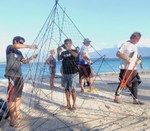
Agustin Rebora (left) and Aaron Joseph secure the structure.
Tom highlighted that bacteria that spread in seas which cause corals to become sick, bleached or to die have not been researched thoroughly. A particular pathogen strain dubbed “the white plague” was first noticed in Florida, spread across the Caribbean in the late 1990s and reached Africa in 2002. It had spread to the Great Barrier Reef of Australia within a year and now can be found afflicting the corals in the Pacific and Indian Oceans, including Indonesia. “Scientists have yet to culture the pathogen and study it, so it is difficult to find the solution,” said Tom.
Due to such real threats destroying corals around the world, it is foolhardy to think that corals are naturally resilient to tackle these threats on their own, said Tom. They are delicate sea animals that cannot run or swim away.
Biorock the Enabler
That is why technology has to step in. Going beyond mere concrete structures, rubber tires and chicken coop mesh, Biorock or electric reef technology can expedite coral growth and more importantly make them more resistant to these environmental threats over time. Biorock materials (also known as Seament, Seacrete or Mineral Accretion) was developed in the early 1970s to grow limestone building materials from the sea.
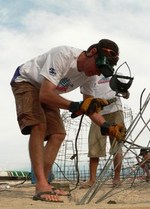
Crispin Gibbs welds steel in place.Biorock method, invented by the late Prof.
Wolf Hilbertz, uses a low voltage direct current (above 1.2 Volts powered by the grid, solar, wind or tidal energy sources) passing through a steel structure underwater to grow solid limestone minerals on conductive substrates. The minerals grown come from seawater, such as calcium carbonate and magnesium hydroxide.
This limestone becomes a natural and conducive base for coral larvae to settle on to grow. To expedite the building of a coral reef, broken fragments are collected from the seabed and tied to the structure. Since the 1980s, the method has seen the growth of limestone reefs in more than 20 countries in the Caribbean, Indian Ocean, Pacific and Southeast Asia.
Hard and soft corals, sponges, tunicates and bivalves can be seen flourishing on the steel structures of various shapes. Hard corals grow between two to six times faster depending on the species. “Exceptionally brightly coloured and densely branched, the corals also heal from physical damage at least 20 times faster and have 16 to 50 times higher survival from the most severe high temperature bleaching events,” said Tom, formerly Senior Scientific Affairs Officer at the United Nations Centre for Science and Technology for Development, in charge of climate change and biodiversity.
Biorock structures can be as small as three metres long (as in the turtle structure) or as big or wide as your imagination can take flight. The electrical conductor is safe to animals and humans. In Gili Trawangan, a huge dome shaped reef exists underwater that’s as tall as a chapel, and as wide. Unfortunately a passing catamaran had dropped an anchor on the structure in 2007, creating a dent. This has not deterred the multitude of fish swimming through the structure though that withstood that impact, and serves as a popular dive site for bubble makers.
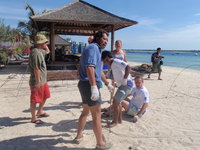
Doing the turtle ain't easy.
According to Tom, the low current prevents, even reverses the rusting of steel substrates. The Biorock material is around three times the compressive strength of ordinary Portland Cement concrete if grown at a rate of less than 1-2 centimetres per year. They grow stronger with age too while other reef growing materials deteriorate or wash away.
Preventing Beach Erosion
Beach resort owners are slowly waking up to the knowledge that the very reefs they destroyed to build their property on are the very guardians of their shoreline. This is because of the protective nature of reefs in slowing the wave action that thrash shores. High wave impact crashes on to the sand of the beach and sucks them out into the deep.
“I have personally seen 12 metres of beach sand right at my doorstep being wiped away in just 5 months,” said Ingrid of Karma Kayak. She attended the workshop to learn how to reverse the damaging situation which destroyed not just the beach but her garden at Gili Trawangan.

Heave ho, Biorock on the go!
Beach sand is a calcerous organism made up of corals and shellfish over time. Without corals, beach sand cannot regenerate itself. In Pemuteran Bay, Bali for instance, around 60 Biorock reef structures restore collapsed fishery, slow down wave action and is naturally restoring the beach with new sand. On the tourist resort island of Ihuru in the Maldives lies a Biorock “necklace reef” of 45 metres long and 4 to 8 metres wide. It has been responsible for the growth of a once-eroding beach by 15 metres over two years.
Workshop participant Crispin Gibbs of Black Marlin Dive Resort intends to take the skills learnt back to his dive resort in Togian Islands of Sulawesi, Indonesia where the reefs are slowly deteriorating. He intends to place a large number of structures in a single location. “Concentrating these structures in one place will be more effective in building reefs, slowing down waves and restoring the beach,” he said, observing that the new structures placed underwater at Gili Trawangan were dispersed.

Creating an underwater nursery.
At the end of the day, it comes down to a collective decision by the community to restore critical stretches of beaches, and not just at participating or sponsoring beach resort house reefs to draw tourists.
“There is no limit in principle to the size of shape of Biorock structures,” said Tom, adding, “they could be grown hundreds of miles long if funding allowed.”
Following the Biorock development closely and convinced of its benefits to the coastal environment and villagers, mathematics teacher Mike Miron of Jakarta International School has secured sponsorship from the school to lay down a Biorock structure in the shallow water. Mike has personally nurtured 50 students to become certified divers and some, eco divers.
Attesting to its benefits, Dephine Robbe who has dived around the island for many years notices the difference. "Biorock has helped the island by providing new dive sites and lots of fish habitats as the corals are growing well on the structures and around," she said. The manager of Gili Eco Trust and Big Bubble Dive Centre has also observed new species such as file fish and frog fish appearing around the new reefs that also serve as nurseries and protective shelters for juvenile fishes.
It just goes to show that with some money, some sweat, a bit of technology and a lot of grit, corals can be thrown a lifeline to cope with the many stresses that threaten their very survival.
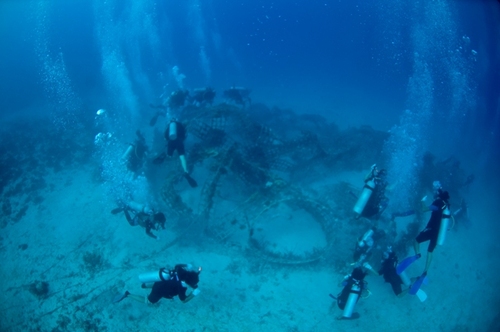
A new habitat is born with a bit of technology.
Underwater photography courtesy of Scotty Graham. Rest by Mallika Naguran.
The Biorock Workshop was supported by Project Aware and PADI Asia Pacific.
The workshop inaugurated the new PADI Introduction to Biorock Process - Distinctive Specialty for PADI Iinstructors where graduates are certified to build Biorock reefs.
For more information on donations or participation, visit:
Global Coral Reef Alliance http://www.globalcoral.org
Contact Dr Thomas J Goreau at goreau@bestweb.net
Gili EcoTrust http://www.giliecotrust.com/
Contact Gili Eco Trust at info@giliecotrust.com
Contact Delphine Robbe of Big Bubble Centre at robbedelphine@yahoo.fr
See related Gaia Discovery article on Gili Trawangan ecotourism.
Read about Thomas J Goreau's background and motivations